Discover 35 hidden attractions, cool sights, and unusual things to do in Hanover (Germany). Don't miss out on these must-see attractions: Hanover Zoo, New Town Hall, and Herrenhausen Gardens. Also, be sure to include Historisches Museum Hannover in your itinerary.
Below, you can find the list of the most amazing places you should visit in Hanover (Lower Saxony).
Table of Contents
Hanover Zoo
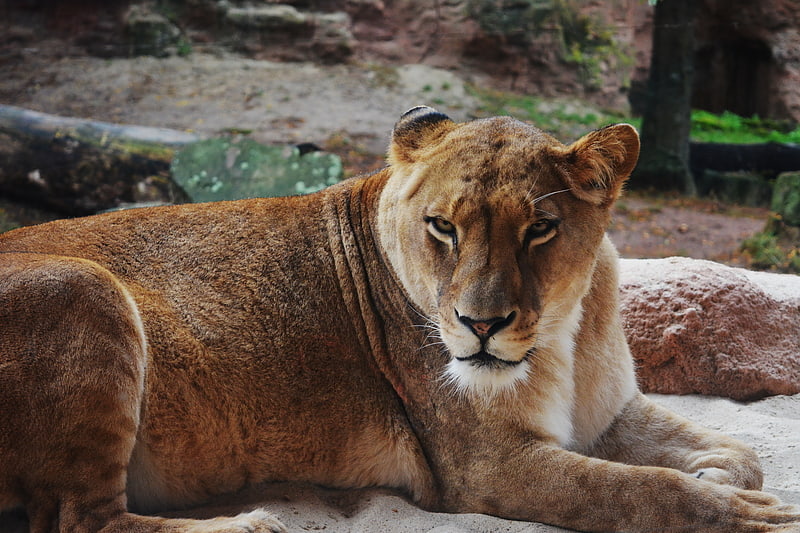
Also known as: Erlebnis-Zoo Hannover
Exotic animals in naturalistic habitats. Hanover Zoo is located in the city centre of Hanover, Germany. The zoo was established on 4 May 1865, and comprises an area of 22 hectares. It contains about 3,414 animals in 237 species, which are cared for by more than 400 employees in the summer season.[1]
Address: Adenauerallee 3, 30175 Hannover (Mitte)
New Town Hall

Also known as: Neues Rathaus
Ornate building with grand dome and views. The New Town Hall in Hanover, Germany, is a city hall and was opened on July 20, 1913, after having been under construction for 12 years. It is a magnificent, castle-like building of the era of Wilhelm II in eclectic style at the southern edge of the inner city. The building is embedded in the 10-hectare Maschpark. The Old Town Hall is no longer used as the main seat of administration, but houses businesses and the registry office.[2]
Address: Trammplatz 2, Hanover (Mitte)
Herrenhausen Gardens

Also known as: Herrenhäuser Gärten
Sprawling, 17th-century formal gardens. The Herrenhausen Gardens of Herrenhausen Palace, located in Herrenhausen, an urban district of Lower Saxony's capital of Hanover are made up of the Great Garden, the Berggarten, the Georgengarten and the Welfengarten. The gardens are a heritage of the Kings of Hanover.
The Great Garden has always been one of the most distinguished Baroque gardens of Europe while the Berggarten has been transformed over the years from a simple vegetable garden into a large botanical garden with its own attractions. Both the Georgengarten and the Welfengarten have been made in the style of English gardens, and both are considered popular recreation areas for the residents of Hannover. The history of the gardens spans several centuries, and they remain a popular attraction to this day.[3]
Address: Herrenhäuser Straße 5, Hanover (Herrenhausen-Stöcken)
Historisches Museum Hannover
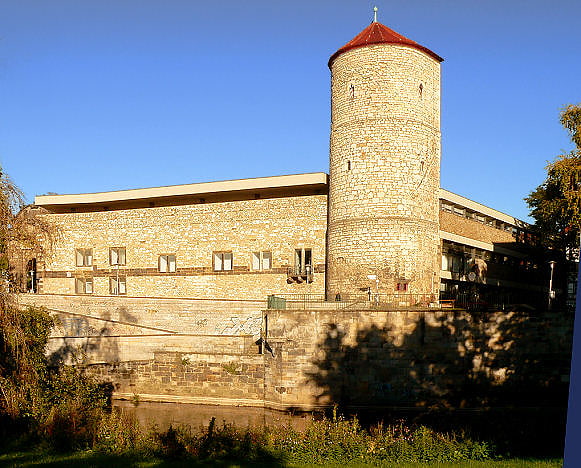
Historisches Museum Hannover is a historical museum Hanover, Lower Saxony, Germany, founded in 1903 as Vaterländisches Museum der Stadt Hannover. Its collections are related to the history of the city, the history of the governing House of Welf, and of the state of Lower Saxony.[4]
Address: Pferdestr. 6, 30159 Hannover (Mitte)
Maschsee

Sizable manman lake for recreation. The Maschsee is an artificial lake situated south of the city centre of Hanover in Germany. Spanning an area of 78 hectares, it is the largest body of water within the capital of Lower Saxony. The lake is a popular recreation area as well as a venue for numerous water sports.[5]
Address: Rudolf-von-Bennigsen-Ufer 70, Hanover (Südstadt-Bult)
Lower Saxony State Museum
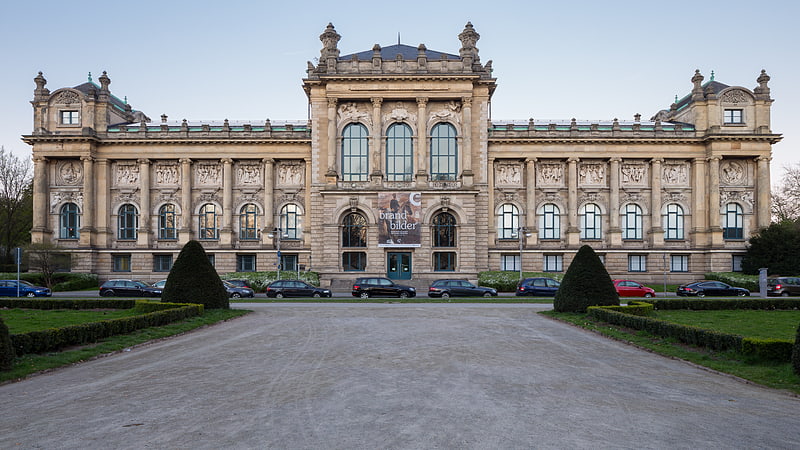
Also known as: Niedersächsisches Landesmuseum Hannover
Regional art, history and biology museum. The Landesmuseum Hannover or Niedersächsisches Landesmuseum Hannover is the museum of Lower Saxony in Hanover, Germany. It is located opposite the New City Hall. The museum comprises the State Gallery, featuring paintings and sculptures from the Middle Ages to the 20th century, plus departments of archaeology, natural history and ethnology. The museum includes a vivarium with fish, amphibians, reptiles and arthropods.[6]
Address: Willy-Brandt-Allee 5, 30169 Hanover (Südstadt-Bult)
The Memorial to the Murdered Jews of Hanover

Cultural landmark in Hanover, Germany. The Memorial to the Murdered Jews of Hanover is located in Hanover, Germany, on Opernplatz, one of the city's central squares. It was designed by the Italian artist Michelangelo Pistoletto and erected in 1994 on the initiative of the Memoriam Association and financed through individual donations. The memorial is adjacent to Hanover's Opera House and commemorates the more than 6,800 Jews of Hanover who were murdered by the Nazis in the Holocaust. To date, 1,935 names have been carved in stone. Their age at the time of deportation was added to the names of the deportees, for the other victims the birth year was added. As far as is known, the subsequent fate of each individual victim was recorded. If the place of death could not be determined, "missing" was noted, as was customary elsewhere.[7]
Niedersachsenstadion

Also known as: HDI-Arena
Stadium in Hanover, Germany. Niedersachsenstadion is a football stadium in Hanover, Lower Saxony, Germany, which is home to 2. Bundesliga football club Hannover 96.
The original 86,000 capacity stadium was completed in 1954 and has since been rebuilt several times for various major football events. Today it has 49,000 covered seats. During the 2006 FIFA World Cup the stadium was named FIFA World Cup Stadium, Hanover.
Through a sponsorship deal, the stadium's official name is currently HDI-Arena. Between 2002 and 2013 a similar arrangement saw the stadium renamed as the AWD-Arena. Starting in July 2022 it will be renamed Heinz von Heiden-Arena.[8]
Address: Robert-Enke-Str. 1, 30169 Hannover (Mitte)
Museum August Kestner
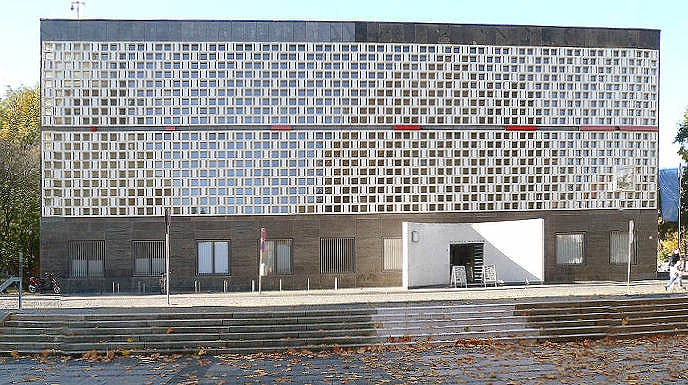
Museum containing diplomat's collections. Museum August Kestner, previously Kestner-Museum, is a museum in Hanover, Germany. It was founded in 1889. The museum was renamed Museum August Kestner in December 2007 to avoid confusion with the Kestnergesellschaft, a local art gallery.
Museum August Kestner is centered on the collections of August Kestner and his nephew Hermann Kestner, later followed by the collections of Friedrich Culemann and Friedrich Wilhelm von Bissing. It contains four different categories of antiquities: Ancient Egypt, Classical Antiquity, Numismatics and Handicraft.[9]
Address: Trammplatz 3, 30159 Hannover (Mitte)
Eilenriede
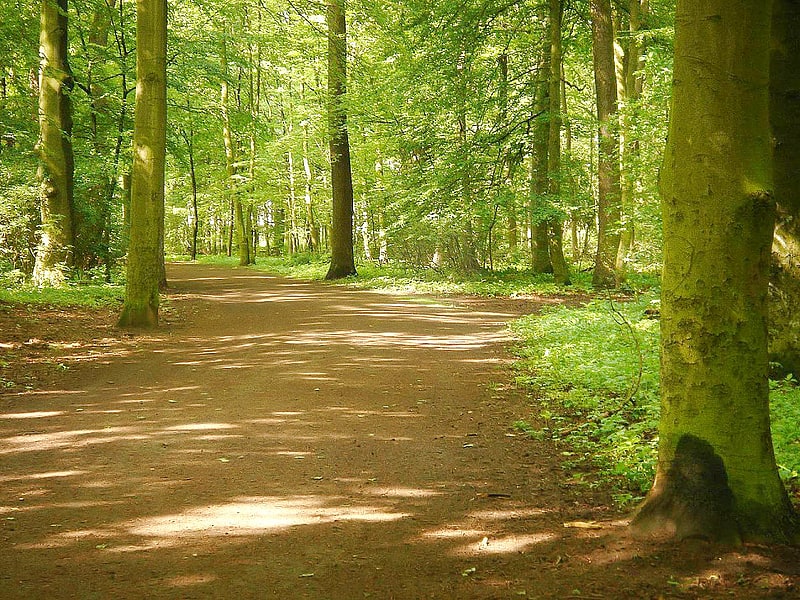
Park in Hanover, Germany. The Eilenriede is a 640-hectare municipal forest in Hannover, Germany. It is the largest urban city forest in Germany, and also one of the largest in Europe. The Eilenriede is nearly twice the size of Central Park. The biggest German urban "park" in the strict sense of the word, however, is the Englischer Garten München, with "only" 375-hectare.[10]
Market Church
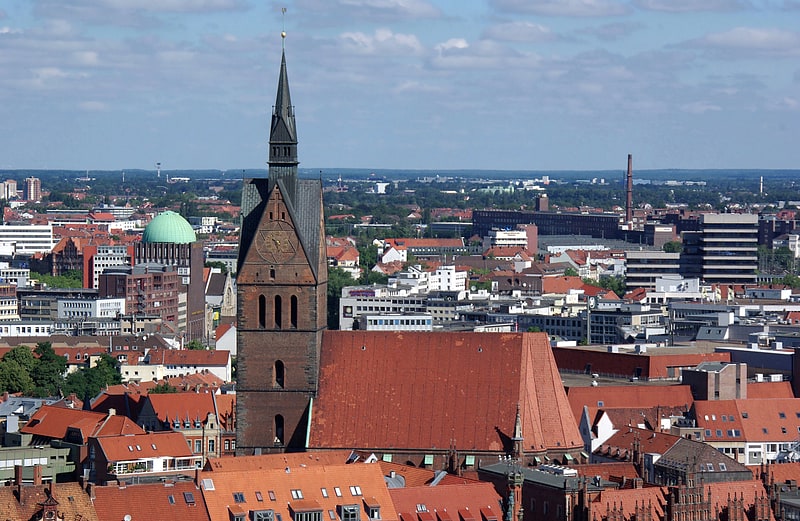
Also known as: Marktkirche
14th-century Lutheran church. The Marktkirche St. Georgii et Jacobi, commonly known as Marktkirche, is the main Lutheran church in Hanover, Germany. It was built in the 14th century and, together with the nearby Old Town Hall, is considered the southernmost example of the North German brick gothic architectural style. The roof and the vaults of the naves were destroyed in an air raid in 1943 and restored in 1952.
The church is a hallenkirche (hall church). Above the nave and two aisles rises a monumental saddleback roof. The high western tower was a symbol for the power and the wealth of the citizens of the town. It is still one of the highest towers in Lower-Saxony and a landmark of the city.[11]
Address: Hanns-Lilje-Platz 2, 30159 Hanover (Mitte)
ZAG-Arena

Also known as: TUI Arena
Arena in Hanover, Germany. ZAG-Arena is an arena in Hanover, Germany. The arena opened in 2000 and holds 10,767, during hockey or handball matches and up to 14,000, during concerts. It is the biggest indoor-venue in the Hanover Region and most major concerts are held there. The arena is situated at the Expo Plaza in the Expo 2000 grounds, in the south of Hanover, astride the Kronsberg and Mittelfeld areas.[12]
Address: Expo Plaza 7, 30539 Hannover (Döhren-Wülfel)
Old Town Hall

Also known as: Altes Rathaus
Restaurant in Hanover, Germany. The Altes Rathaus was the first town hall in the German city of Hanover. First built in the old city district in 1410 and extensively restored in 1953 and 1964 after heavy bomb damage in World War II, it is the oldest secular building in the city. The market façade with the highly sophisticated Brick Gothic of the lucarnes has been preserved and partly restored in its medieval shape. Some elements of it were copied on other wings of the building.[13]
Address: Karmarschstraße 42, 30159 Hannover (Mitte)
Evangelical Church Centre Kronsberg
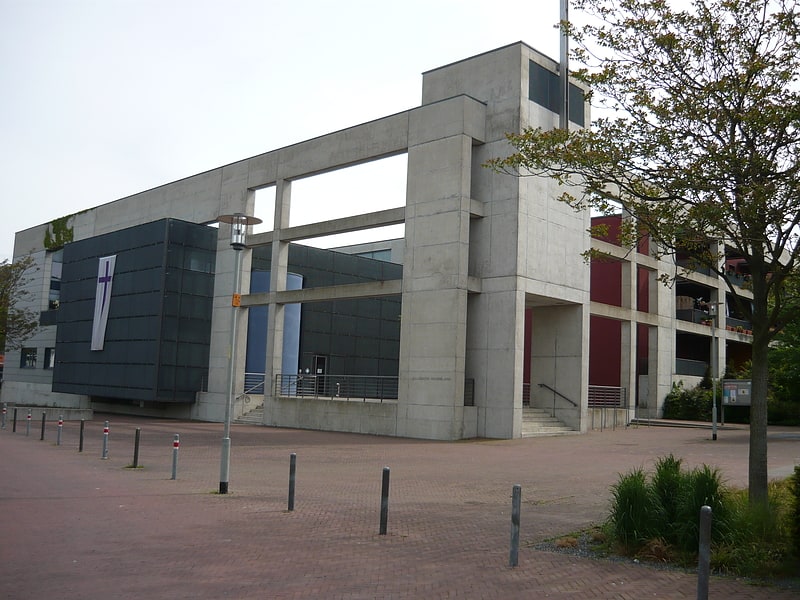
Also known as: Evangelisches Kirchenzentrum Kronsberg
Evangelical church in Hanover, Germany. The Evangelical Kronsberg Church Centre is a place of worship in the Kronsberg neighbourhood of Hanover, in Lower Saxony, Germany. The Church belongs to the St. Johannis-Kirchengemeinde Bemerode parish, within the Evangelical-Lutheran Church of Hanover. The church centre is a simultaneum, hosting Baptists as well as Lutherans for prayer services.[14]
Address: Thie 8, 30539 Hannover (Kirchrode-Bemerode-Wülferode)
Swiss Life Hall
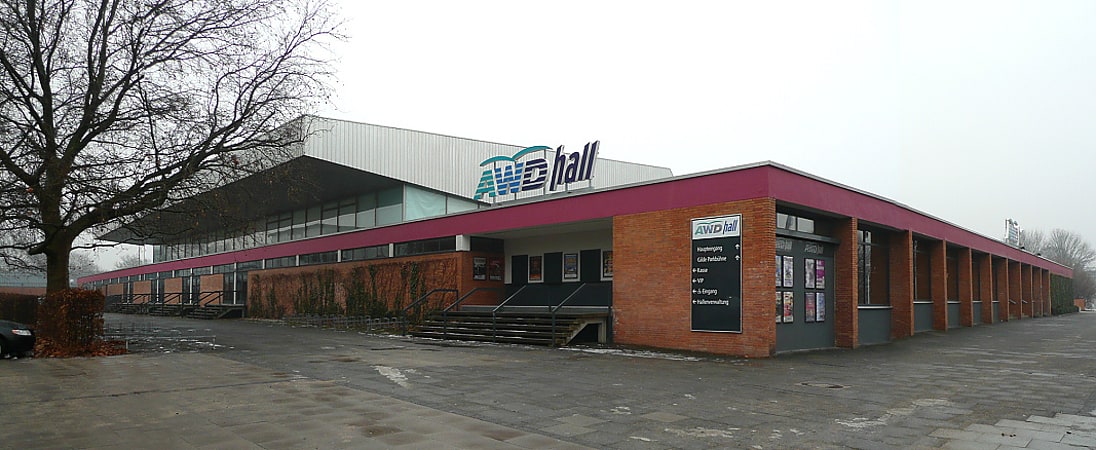
Arena in Hanover, Germany. Swiss Life Hall is an indoor arena, in Hanover, Germany. The hall can hold 5,500 people and is sponsored by the Swiss Life insurance company.
It mainly hosts indoor sporting events, concerts and trade shows. On 6 May 2001, Irish vocal pop band Westlife held a concert for their Where Dreams Come True Tour supporting their album Coast to Coast.[15]
Address: Ferdinand-Wilhelm-Fricke-Weg 8, 30169 Hannover (Mitte)
Leineschloss
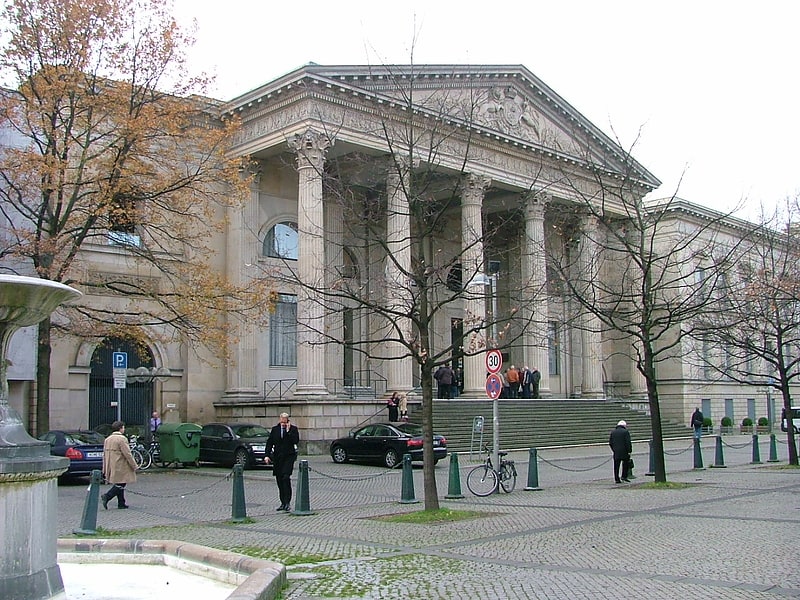
Reconstructed Neoclassical palace. The Leineschloss, situated on the Leine in Hanover, Germany, is the former residence of the Hanoverian dukes, electors and kings. Currently it is the seat of the Landtag of Lower Saxony.
The first building on the site was a Franciscan friary, constructed in about 1300, which was abandoned in 1533 after the Protestant Reformation. In 1636, George, Duke of Brunswick-Lüneburg, began construction of a rather small late renaissance palace on the site as his residence. Elector Ernest Augustus had it enlarged and modernized and added a theatre in the late 17th century. In 1742 the north-west wing was renewed. Between 1816 and 1844, the architect Georg Ludwig Friedrich Laves fully re-built the palace. The column portico with six Corinthian columns was built during this period.
During World War II, the Leineschloss burnt out entirely after British aerial bombings. King George I of Great Britain was originally buried in the Chapel of the Leineschloss, but his remains, along with his parents', were moved to the 19th-century mausoleum of King Ernest Augustus in the Berggarten of Herrenhausen Palace after World War II. Architect Dieter Oesterlen re-built the palace between 1957 and 1962.
In August 2016 bones were found in the Leineschloss during a renovation project; it was believed that the bones were the remains of Philip Christoph von Königsmarck, the lover of the wife of the later king George I of Great Britain who was killed there in July, 1694. However, subsequent tests proved that some of the bones were from animals, while the human bones came from at least five different skeletons. None have been proven to belong to Königsmarck.[16]
Address: Hinrich-Wilhelm-Kopf-Platz 1, 30159 Hanover (Mitte)
Aegidientorplatz

The Aegidientorplatz, colloquially known as Aegi is a busy square in Hanover located above the U-bahn station of the same name. The square was named for the Aegidientor, one of the city gates of Medieval Hanover, which existed until 1780.[17]
Kestnergesellschaft
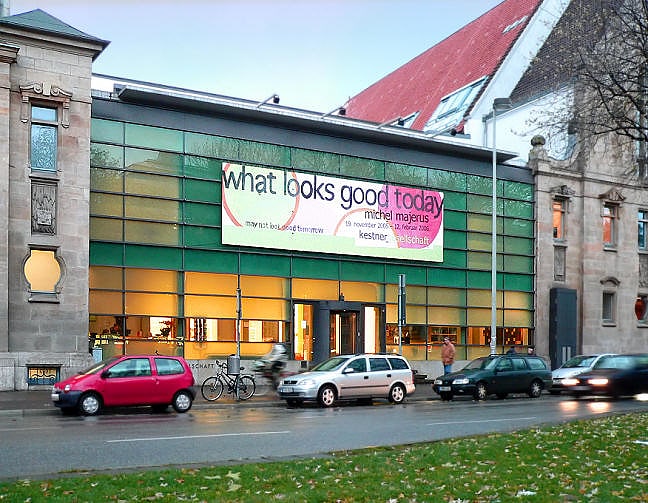
Cutting-edge art in old swimming baths. Kestner Gesellschaft is an art institution in Hanover, Germany, founded in 1916 to promote the arts. Its founders included the painter Wilhelm von Debschitz. The association blossomed under the management of Alexander Dorner and Justus Bier, pioneering modern art.
After World War II, Alfred Hentzen took over the management in 1947, followed by Fritz Schmalenbach. In 1997 the Kestner Gesellschaft moved into new premises at Goseriede 11, the former site of the Goseriede Aquatic Center. The new gallery is next to the Hannoversche Allgemeine Zeitung, Hanover's newspaper.
The institution hit the headlines in 2005 when it exhibited a mud house created by Spanish artist Santiago Sierra featuring a room with mud floor reminiscent of Hanover's Maschsee, an artificial lake.
The institution’s current and first female director is Christina Végh.[18]
Address: Goseriede 11, 30159 Hannover (Mitte)
Sprengel Museum
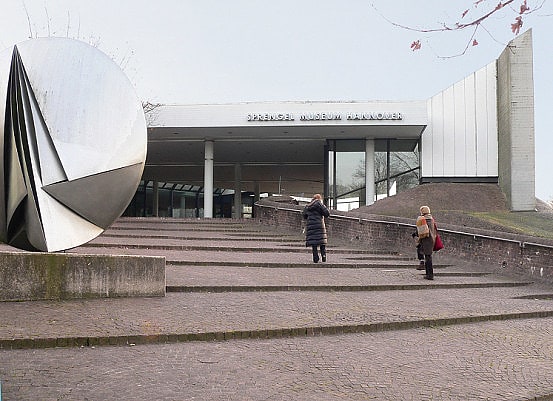
Cutting edge contemporary art museum. Sprengel Museum is a museum of modern art in Hanover, Lower Saxony, holding one of the most significant collections of modern art in Germany. It is located in a building designed by Peter and Ursula Trint and Dieter Quast, adjacent to the Maschsee. The museum opened in 1979, and the building was extended in 1992.
Bernhard Sprengel donated his extensive collection of modern art to the city of Hanover in 1969, as well as financially supporting the construction of the museum. The city of Hanover and the state of Lower Saxony agreed to jointly operate the museum. In addition to the works donated by Sprengel, the museum also houses 20th century artworks owned by Lower Saxony and Hanover.[19]
Address: Kurt-Schwitters-Platz 1, 30169 Hannover (Südstadt-Bult)
Theater am Aegi
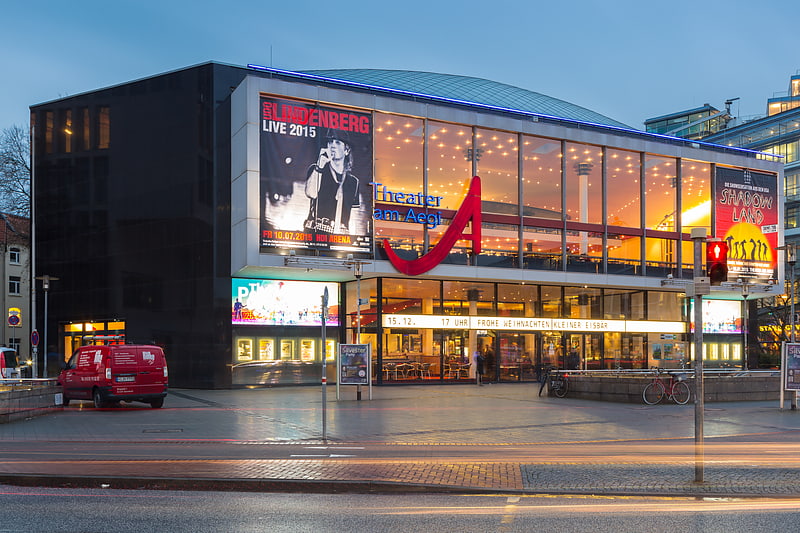
Performing arts theater in Hanover, Germany. The Theater am Aegi is an event venue on Aegidientorplatz square in Hannover, the capital of Lower Saxony, Germany. Like the square, it is often referred to as Aegi. The building was opened in 1953 mainly as a cinema, with a versatile stage also for other performances. It has been a Gastspieltheater for local and touring companies, without its own personnel. After a fire, it was rebuilt as a theatre only, opened in 1967, and then mainly as a venue for drama performances of the state-run Staatstheater Hannover. After a new theatre was built for that company in 1992, Theater am Aegi returned to its traditional role of a venue for various events, including congress, private functions and representation of the city.[20]
Address: 2 Aegidientorplatz, Hanover (Südstadt-Bult)
Schauspiel Hannover

Performing arts theater in Hanover, Germany. The Schauspiel Hannover is part of the theatre organisation of the German state of Lower Saxony in its capital, Hanover, the Niedersächsische Staatstheater Hannover. The other part is the Staatsoper Hannover. Schauspiel offers theatre, entertainment and music on five stages, the Schauspielhaus, the Cumberlandsche Bühne, the Cumberlandsche Galerie, and the historic buildings in Old Town, Ballhof Eins and Ballhof Zwei.[21]
Address: 9 Prinzenstraße, Hanover (Mitte)
St. Clement's Basilica
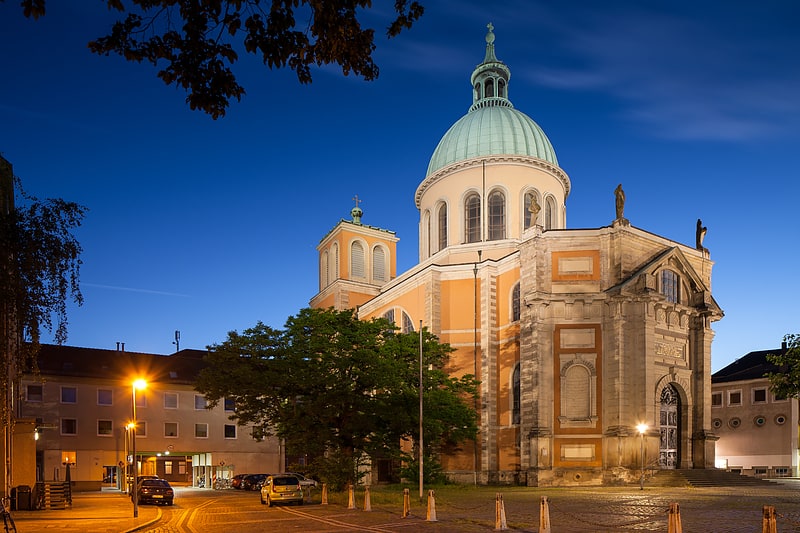
Also known as: St. Clemens
Catholic church in Hanover, Germany. St. Clement's Basilica is the main Roman Catholic church in the city of Hanover. It is dedicated to Saint Clement of Rome. It is part of the parish of St. Heinrich and belongs to the Diocese of Hildesheim.[22]
Address: Platz an der Basilika 2, Hanover (Mitte)
Wilhelm Busch Museum

Also known as: Wilhelm Busch – Deutsches Museum für Karikatur und Zeichenkunst
Museum of caricature and cartoon art. The Wilhelm Busch Museum is a museum in Hanover, Lower Saxony, Germany. It features the world's largest collection of works by Wilhelm Busch, as well as contemporary comic art, illustrations and drawings.
It is located in the Georgengarten (part of the Herrenhausen Gardens) in a palace known as the Georgenpalais, dating from around 1780. The museum is run by the Wilhelm Busch Society, which formed in 1930.[23]
Address: 1 Georgengarten, 30167, Hannover, Hanover (Nord)
Georgengarten
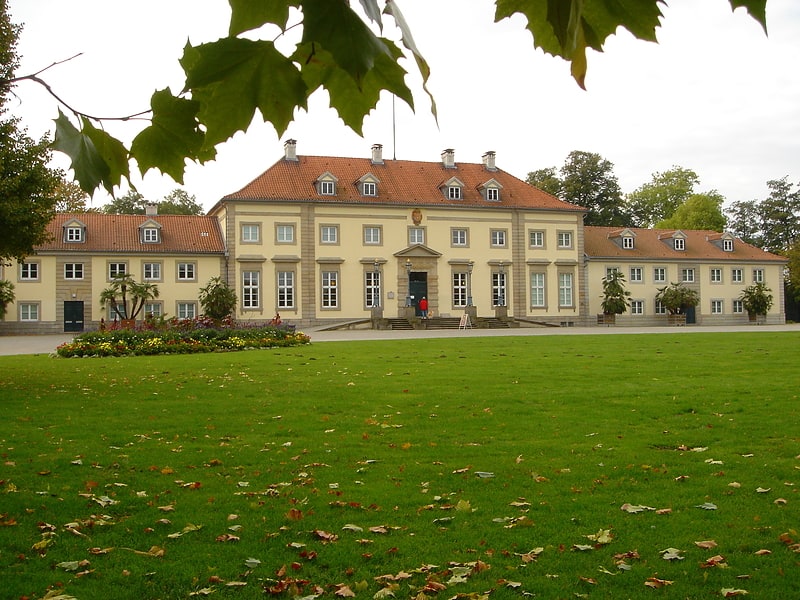
State park in Hanover, Germany. The Georgengarten is a landscape garden in the northwestern borough of Herrenhausen of the German city Hanover. It is a part of Herrenhausen Gardens.[24]
Church of the Holy Cross

Also known as: Kreuzkirche
Church in Hanover, Germany. The Kreuzkirche is a Lutheran church in the centre of Hanover, the capital of Lower Saxony, Germany. The Gothic hall church is one of three churches in its Old Town; the other two are the Marktkirche and the now-ruined Aegidienkirche. It was dedicated in 1330 to the Holy Cross.
The church became Lutheran in the Reformation. It was expanded then, and renovated in the 19th century. Destroyed by bombs in World War II, it was rebuilt in simpler form. It received an altar by Lucas Cranach which had been in the Schlosskirche that was not rebuilt. The official name became then Schloss- und Stadtkirche St. Crucis Hannover (Palace- and town church of the Holy Cross). From 1982, the Kreuzkirche parish became part of the Marktkirche parish.[25]
Address: Kreuzkirchhof 3, 30159 Hanover (Mitte)
Landesfunkhaus Niedersachsen
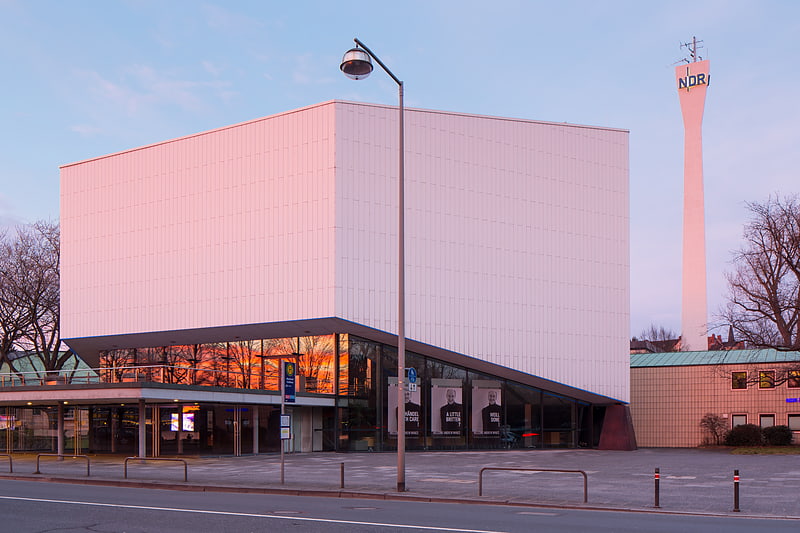
Landesfunkhaus Niedersachsen is a group of buildings of the public broadcaster Norddeutscher Rundfunk in Hanover, the state capital of Lower Saxony.
The broadcaster is based in Hamburg, but has facilities in the capitals of other states that it serves. The Funkhaus is located on the Maschsee at the Rudolf-von-Bennigsen-Ufer. When it was built from 1949 to 1952, it was known as the Funkhaus Hannover (Broadcast station Hannover). It includes two halls for public concerts, Großer Sendesaal (1963) and Kleiner Sendesaal, also administrative buildings and an antenna tower.[26]
Silbersee
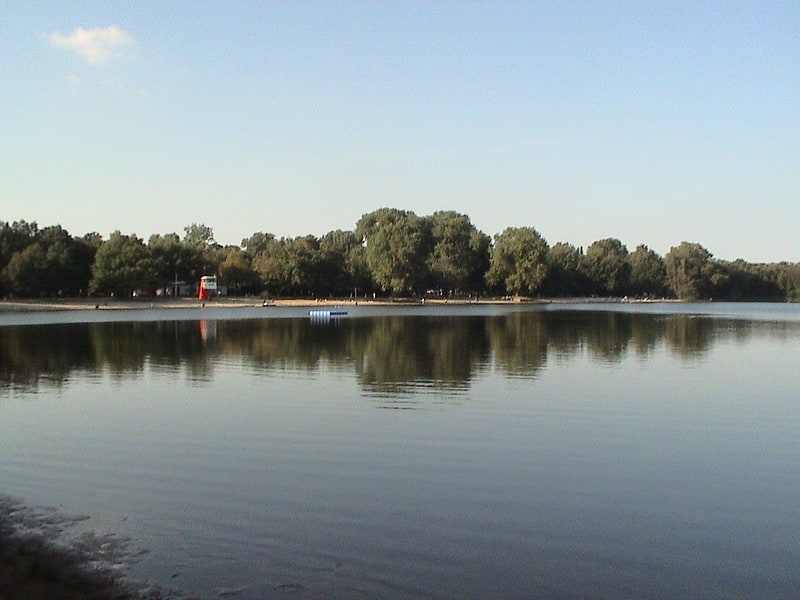
Lake in Germany. Silbersee is a lake in Langenhagen, Lower Saxony, Germany.[27]
Maschseebad - Strandbad Maschsee
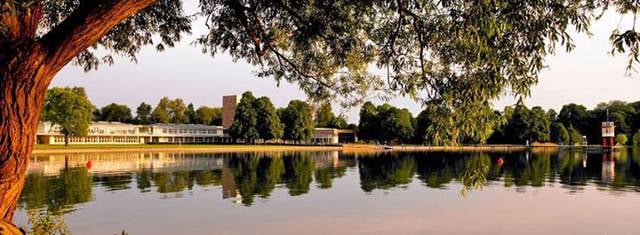
Beach, Bathing area
Address: Rudolf-von-Bennigsen-Ufer 83, 30519 Hannover (Südstadt-Bult)
Gartenfriedhof
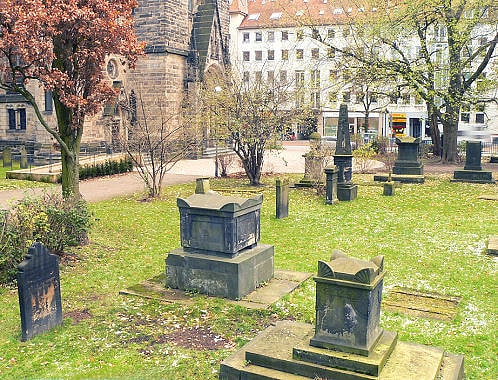
Cemetery. The Gartenfriedhof or Garden Cemetery is a cemetery in Hanover, created in 1741 and located by the Gartenkirche. The cemetery and the church are both named after the garden parish outside the city walls in front of Aegidien gate. The cemetery, which contains a number of classicising grave markers from the first half of the nineteenth century, was closed in 1864 with the establishment of the Stadtfriedhof Engesohde. Today it forms a park in the middle of inner city Hanover. The graves of Charlotte Buff, the astronomer Caroline Herschel and the painter Johann Heinrich Ramberg are located here. The Gartenfriedhof lies on Marienstraße between Warmbüchenstraße and Arnswaldtstraße.[28]
Hanover War Cemetery

Also known as: Hannover War Cemetery
Cemetery in Seelze, Germany. The Hanover War Cemetery is a military cemetery owned by the Commonwealth War Graves Commission. The cemetery is immediately adjacent to the city of Hannover, and is more precisely located in the city of Seelze.[29]
Address: Harenberger Meile, Hanover
Neustädter Kirche
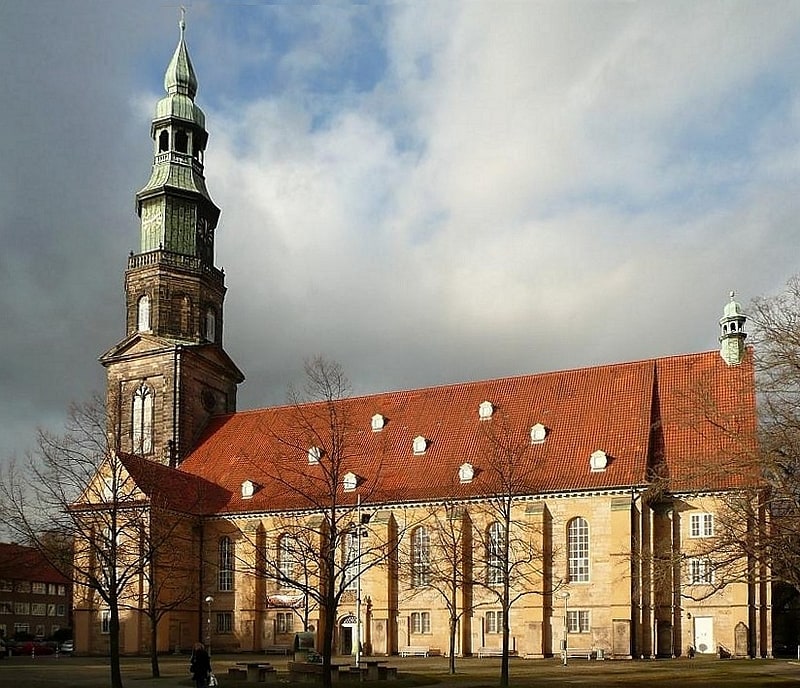
Also known as: Neustädter Hof- und Stadtkirche St. Johannis
Church in Hanover, Germany. The Neustädter Kirche is a main Lutheran parish church in Hanover, Lower Saxony, Germany. The official name is Neustädter Hof- und Stadtkirche St. Johannis zu Hannover. The Baroque church was built in 1666–70. It is one of the oldest Protestant Saalkirchen in Lower Saxony, conceived for the sermon as the main act of the Lutheran church service. Mathematician and philosopher Gottfried Wilhelm Leibniz and Field Marshal Carl August von Alten are buried here.
The church is known for its church music, performed in service and concert by the Kantorei St. Johannis (St. John's chorale), and serves as a venue for concerts, for example in the context of the Expo 2000 and the Kirchentag. It houses a "Spanish organ", suitable for early Baroque music, in collaboration with the Hochschule für Musik und Theater Hannover.[30]
Address: Rote Reihe 8, Hanover (Mitte)
Schauspielhaus
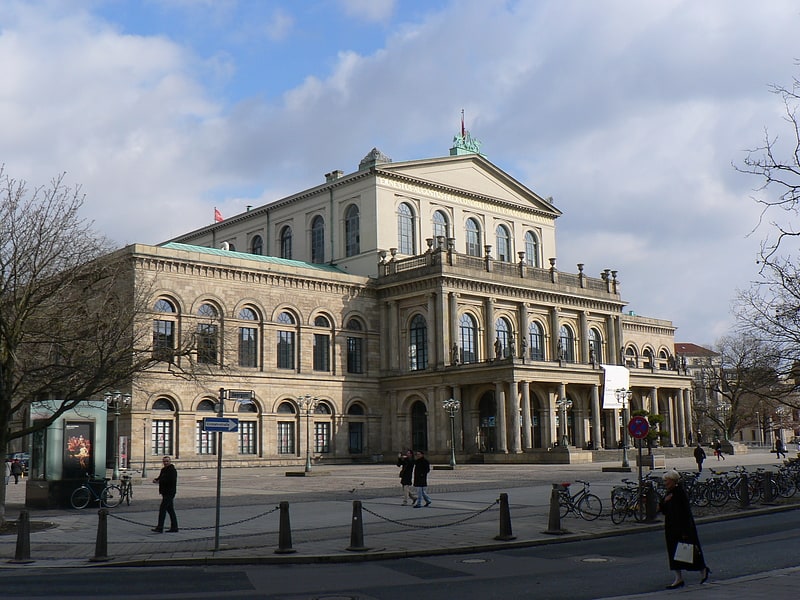
Also known as: Opernhaus
Opera company. Staatsoper Hannover is a German opera house and company in Hanover, the state capital of Lower Saxony. It is part of the Niedersächsische Staatstheater Hannover, which puts on operas, stage productions, and concert programs. It consists of the divisions Schauspiel Hannover, Staatsballett Hannover, Staatsorchester Hannover and Theatermuseum Hannover. Its season runs from September to June.[31]
Address: Prinzenstr. 9, 30159 Hannover (Mitte)
Telemax
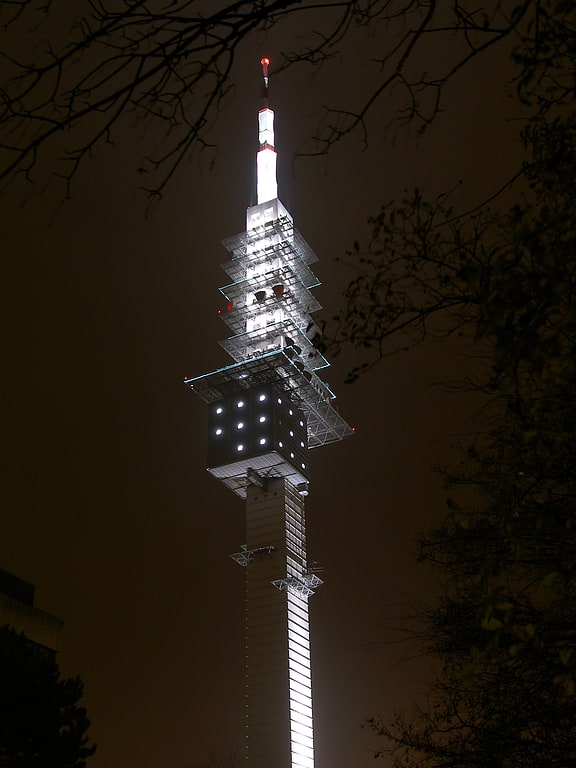
The Telemax is a telecommunication tower built from 1988 to 1992 in Hanover. The tower was designed by Hans U. Boeckler and is 272 metres metres high. The tower stands on a 10 metres high base building, which brings its overall height to 282 metres. The tower is the fifth tallest TV tower in Germany. The owner and operator of the site is Deutsche Funkturm, a subsidiary of Deutsche Telekom.[32]
Address: Neue Land Strasse 6, Hanover (Buchholz-Kleefeld)
Herrenhäuser Kirche
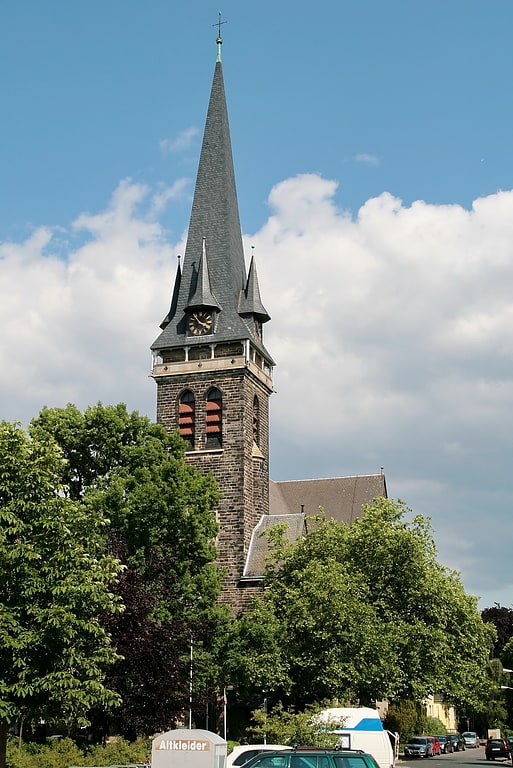
Evangelical church in Hanover, Germany. The German: Herrenhäuser Kirche in Hanover-Herrenhausen, Lower Saxony, Germany) is a church built in neo-Gothic style. Located close to the Herrenhausen Gardens, it belongs to the Lutheran congregation of the Herrenhausen-Leinhausen parish and is a listed historic building.[33]
St. Maria Angelica
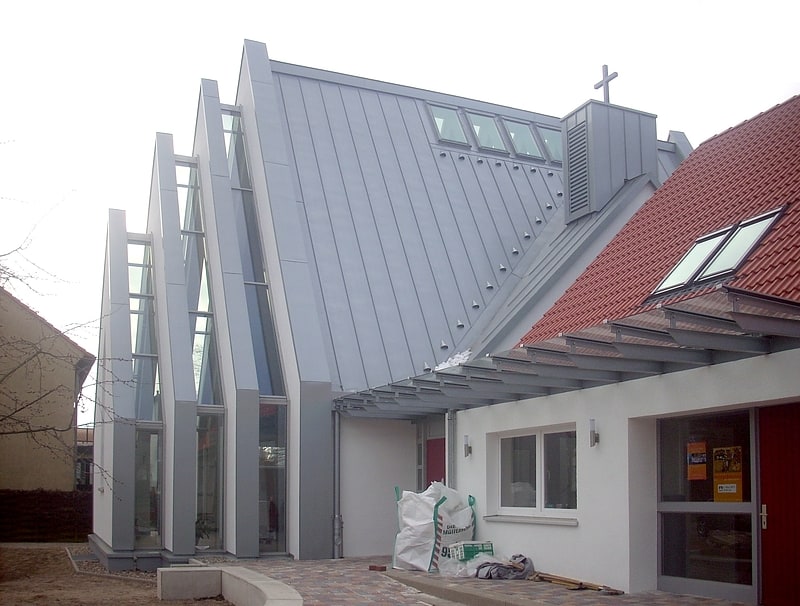
Catholic church in Hanover, Germany. The Parish Church of St. Maria Angelica in Hanover, Germany, is the church of the Old Catholic Parish of Hanover/Southern Lower Saxony. The church, which has been in use since 2010 and was consecrated on 3 September 2011, is located on a property that originally belonged to the neighbouring Lutheran parish of St. James. The land was purchased in 2003 by the Old Catholic parish.[34]
Address: Brabeckstraße 24, 30559 Hannover (Kirchrode-Bemerode-Wülferode)